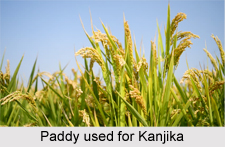 Kanjika is a form of medicine which is a sour liquid produced from the acetous fermentation of powdered paddy. Kanjika is a clear transparent fluid with an acid taste and vinous smell. It is cooling, refrigerant, and useful as a drink in fever, burning of the body, etc.
Kanjika is a form of medicine which is a sour liquid produced from the acetous fermentation of powdered paddy. Kanjika is a clear transparent fluid with an acid taste and vinous smell. It is cooling, refrigerant, and useful as a drink in fever, burning of the body, etc.
Other grains besides paddy are sometimes used for acetous fermentation. If mustard or the seeds of Raphanua sativus (mulaka) are added to paddy, the resulting fluid is called "Sintaki". If the husked grains of barley are boiled and steeped in water, the resulting acid liquor is called "Sauvira". When the husks of fried masha- kalaya (pulse of Phaseolus Roxburghii) and barley are boiled together for acetous fermentation, the acid is called "Tushamvu".
Preparation of Kanjika
Two seers of powdered aus dhan (paddy grown in rainy season), are steeped in 8 seers of water and laid aside in an earthen pot for 15 days and upwards, when the mixture undergoes acetous fermentation. The resulting fluid is called Kanjika or Dhanyamia, that is, the acid produced from paddy.
Application of Kanjika
Kanjika is useful as a drink in fever, burning of the body, etc. It is also a cooling and refrigerant kind of medicine which is sometimes applied externally upon the principle of wet-sheet packing, cloth steeped in the fluid being wrapped round the body for relief of high fever and heat of body. It is also used as a vehicle for other medicines and for preparing decoctions, oils, etc.
This article is a stub. You can enrich by adding more information to it. Send your Write Up to content@indianetzone.com
Related Article
Charaka Samhita
Classification of Medicine by Charaka
Traditional Indian Medicines
Traditional Indian Medicine in Ancient Period
Ancient Hindu Medicine
Ancient Vedic Medicine Practitioners
Primitive Medicinal Practices in India
Fever




















